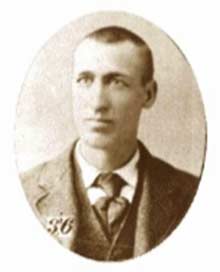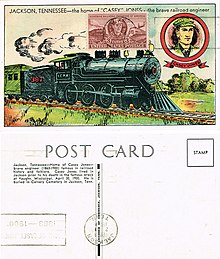Casey Jones | |
|---|---|
 | |
| Born | John Luther Jones March 14, 1863 Missouri, U.S. |
| Died | April 30, 1900 (aged 37) Vaughan, Mississippi, U.S. |
| Cause of death | Train wreck |
| Burial place | Mount Calvary Cemetery, Jackson, Tennessee, U.S. |
| Nationality | American |
| Other names | John Jones |
| Occupations |
|
| Years active | 1878–1900 |
| Spouse |
Mary Joanna Brady (m. 1886) |
| Children | 3 |
John Luther "Casey" Jones (March 14, 1863 – April 30, 1900) was an American railroader who was killed when his passenger train collided with a stalled freight train in Vaughan, Mississippi.
Jones was a locomotive engineer for the Illinois Central Railroad, based in Memphis, Tennessee, and Jackson, Mississippi. He was noted for his exceptionally punctual schedules, which sometimes required a degree of risk, though this was not a factor on his fatal last journey. However, there is some disagreement about the sequence of events on that night, April 29–30, 1900.
He was due to run the southbound passenger service from Memphis to Canton, Mississippi, departing 11:35 p.m. Owing to the absence of another engineer, he had to take over another service through the day, which may have deprived him of sleep. He eventually departed 75 minutes late, but was confident of making up the time with the powerful ten-wheeler Engine No. 382, known as "Cannonball". This was then later referenced in a New York newspaper to describe Erwin Baker and his now infamous "Cannonball Run".[1]

Approaching Vaughan at high speed, he was unaware that three trains were occupying the station, one of which was broken down and directly on his line. Some claim that he ignored a flagman signaling to him, though this person may have been out of sight on a tight bend or obscured by fog. All are agreed, however, that Jones managed to avert a potentially disastrous crash through his exceptional skill at slowing the engine and saving the lives of the passengers at the cost of his own. For this, he was immortalized in a traditional song, "The Ballad of Casey Jones".
- ^ "AMA Motorcycle Hall of Fame: Erwin 'Cannonball' Baker". Motorcycle Hall of Fame. Pickerington, OH USA: American Motorcyclist Association. Retrieved October 22, 2011.